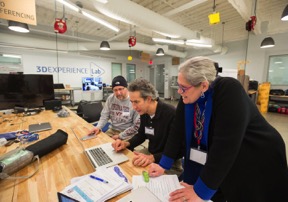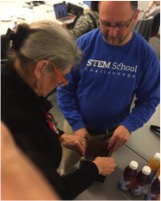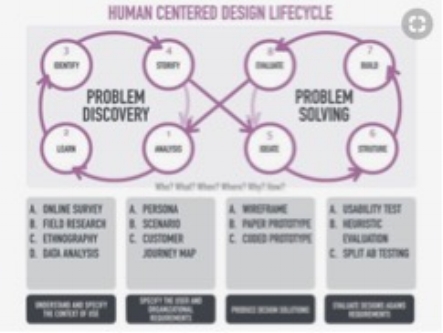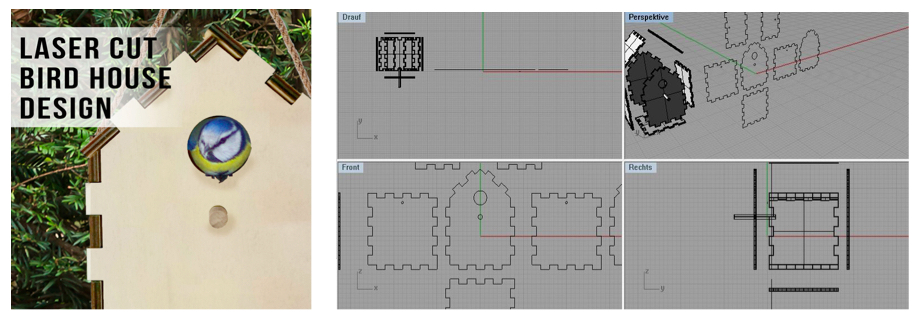By: Tony Donen, Ken Kranz, and Sherry Lassiter
This blog encapsulates the experiences of three educators and their reflections after implementing a digital fabrication unit titled “Animal Engineers”. The emotions, experiences and takeaways about digital fabrication are built from one reflection to the next. In all, the blog represents the full richness of a digital fabrication learning experience from multiple perspectives.
From Tony Donen:
December 17th… seemed like a great day to travel out of Chattanooga, Tennessee to Boston, Massachusetts to meet with a team of implementers and experts on k-12 digital fabrication education. But if you know anything about Chattanooga, you also know most flights go through Atlanta, Georgia first. Turns out, December 17th also happened to be the same day the Atlanta airport lost power. Needless to say, the next 24 hours took plenty of twists and turns before the Chattanooga educators, including me, were able to slog themselves into Boston.
Soon after we arrived, where I can honestly say that I was tired and somewhat cranky, the Fab Foundation Master Fabricator grouped all the varied educators into teams to work through different digital fabrication lessons constructed by educators from across the country.
Our team was comprised of Sherry Lassiter, President and CEO of the Fab Foundation (well rested on far right), Ken Kranz, Fab Lab instructor at STEM School Chattanooga (somewhat tired in the middle), and me, Tony Donen, Principal of STEM School Chattanooga (exhausted on far left).

Photos © Stan Rowin stanstudio.com
But good news was on the horizon for me….
Turns out that there is a way to trick one’s mind and body into thinking you are not exhausted – it’s through interest and engagement. These two attributes rose to the forefront with me as we started into our team’s lesson – Animal Engineers. My wife and daughters would probably laugh at my interest in this lesson because they know I am not an animal lover. In fact, I am allergic to both cats and dogs. However, I was drawn immediately into this lesson for several reasons.
I love to create. In this lesson we were provided the opportunity to build a birdhouse. Not just any birdhouse, but our own design. Anytime I have the opportunity to create and be original, I get energized. Sitting and listening to someone lecture is not my style.
I am a tweaker. Animal Engineers provided the opportunity to think, build, tinker, and re-build. In fact, I am pretty sure our team would have gone for hours and hours if there wasn’t a time constraint put on us.
I am not an expert! If I had been handed this lesson and told to go, I would have hit roadblocks all over the place. From my lack of expertise in technical pieces of digital fabrication to my lack of animal knowledge, I could have floundered. But by working in a collaborative team which brought three of us together with widely varied skill sets, the project took off. It really provided me the opportunity to shine in areas that I already had confidence and learn in areas where my content was lacking.
Overall, the Animal Engineer lesson was well designed in transforming the experience from a sit, listen, talk framework into a make and do experience. We sketched out our ideas and designs, worked with digital fab tools in making our designs come to life, and even scavenged materials from throughout the lab to put together a first rough prototype. In the end I could have gone for hours longer. My exhaustion was completely transformed into engagement, and I appreciated how much this making experience transformed my mentality. It really confirmed to me how much experiences like this matter to our students.
From Ken Kranz:
Think, Make, Try! Our goal was to take an existing lesson from the SCOPES-DF website, and make small improvements, adaptations, or extensions to that lesson and demonstrate the use of a digital fabrication process by making a simple artifact that reflects the improvement. Sounds like fun! Oh…we only have one hour…we can still do this… we were encouraged to keep our initial ideas as simple and open as possible. As the designated “fabber”, I was asked to facilitate the fabrication of our prototype. Our group quickly reviewed the Animal Engineers lesson and brainstormed ideas for things we could make. It was exhilarating to drop into a Fab lab and immediately feel at home. Laser cutter…check. 3D printer…check. ShopBot…check. Any electronic components we might use? Check. Soon we were off and running with wild ideas! But wait, we only have 50 minutes left? Yikes–time to focus!

Photos © Stan Rowin stanstudio.com
Our group quickly sketched a few ideas for a digitally fabricated bird house. Maybe it could be a hexagonal design with a sensor to detect the presence of a bird. That sensor could activate a light to signal the humans that a bird occupant had checked in.
Time check…only 42 minutes to go! Recognizing that time was passing by quickly, it was time to focus on fabrication. Piece of cake, right? Well, maybe not. We quickly decided the laser cutter would be the quickest way to digitally create our prototype, however, our colleagues (and competitors) had come to the same conclusion. Oh no! Resource contention! We also noted that each Fab lab has its unique quirks and tools. We were familiar with using a certain type of vector drawing software but it was not available. No problem, right? Wrong! We struggled to perform what should have been a very simple task–creating a vector shape of our bird house. We even simplified the idea to a cube-based design. Thankfully, the Fab lab staff came to our rescue and assisted with the software aspect. The Fab lab was stocked with ample supplies of cardboard–an essential for digital fabrication! Soon enough, our design was taking form. We laser cut and assembled a simple cube model. We even used the vinyl cutter to apply a “waterproof” exterior coating. Not bad for a quick prototype!
In looking back on our experience, I reflected on the value of putting myself in the role of a student learner. Doing so always helps me relate to the challenges our students face and can be invaluable…and humbling. Like our students, I was was working with new people on an unfamiliar project. Getting organized and making sure we understood the expectations was critical. I had assumed I could quickly figure out software tools to create a design for the laser cutter. However, I found myself confounded with unfamiliar features, not unlike our students who are using our software tools for the first time. On the positive side, having readily available resources was reassuring. If we made a mistake, we could easily make another prototype. That’s the type of freedom we want our students to have.
In conclusion, I found even a seasoned “fabber” like myself had a lot to learn about digital fabrication and how to design effective projects to help students become fabbers as well!
From Sherry Lassiter:
Picking up from Tony and Ken, I’m interested in how we take this wonderful, engaging activity and make it relevant and even more engaging for middle or high school students…or even adults like us!
My last career was as a television producer for educational TV, both public and commercial. And one of my last TV gigs was as series producer for a show called All Bird TV, a documentary series funded by The Learning Channel, and about (as you can imagine) birds! The show was hosted by Ken Dial, a biology professor at the University of Montana and affiliated with the Museum of Comparative Zoology at Harvard. He was a wild, adventurous man, afraid of nothing and totally into birds. He has interesting new theories about bird evolution and flight. He taught me most of what I know and love about birds.

Ken Dial (Google image), Ruby-throated Hummingbird nest, Sociable Weaver nests (BBC Earth, 2015,Retrieved 04/16/2018 from: https://www.bbc.com/earth/story/20150307-the-16-most-amazing-bird-nests
What I learned from Dial is that birds are amongst the best engineers in the world. From the lichen covered cups of the Ruby-throated Hummingbird (Archilochus colubris), to the social network nests of the Sociable Weaver (Philetairus socius), to the layered saliva nests of the Edible-nest Swiftlet (Aerodramus fuciphagus), the size, shape and architecture of each is unique, yet all have survival of the species at heart.
Of course I have my own personal favorite bird engineer, the Vogelkop Bower Bird. The male is both engineer and artist. He builds a house/nest as part of his courtship for a mate, which is in fact a species survival issue. Now this particular bird nest strategy may or may not be appropriate for 3rd to 5th graders, but I’ll bet you that middle and high schoolers will get a kick out of it.
VIDEO: https://www.youtube.com/watch?v=E1zmfTr2d4c
In the original animal engineer lesson students think about the materials and tools one could use to build a nest, they see animal-designed nests as well as human-designed nests and then they prototype a nest that has similar protective characteristics to those of a bird-designed nest. So how do we advance and deepen the learning and engagement here for older students, through digital fabrication? Digital fabrication gives us the opportunity to make precision objects, repeatably and reliably. It also allows us to create logical, functional systems, to sense, measure and modify the environment, to collect data and analyze that data in ways that enable us to model and make predictions about the world around us.
First I’d start with the Engineering Design Process. Engineering design is about defining the problem, designing a solution, prototyping a solution, testing it, reflecting on what does and doesn’t work and redefining or iterating. There are a million versions of the circular engineering design process out there, but below are two frameworks… one for advanced students, and my favorite spiral for lifelong learners from MIT’s Lifelong Learning Group.

All I Really Need to Know (About Creative Thinking) I Learned (By Studying How Children Learn) in Kindergarten* , M.Resnick, MIT Media Lab handout, Pg. 2, Retrieved 04-16-2018 from: /wp-content/uploads/2018/06/kindergarten-learning-approach.pdf
But engineering design isn’t just about a problem and a solution, it’s really about the end user and relates very much to Human-Centered Design. The graphic below shows how the human experience needs to be explored thoroughly before we begin the physical design process.

The art and science of Human-Centered Design, 2015, Mario Sakata. Retrieved 04-16-2018 from: https://www.pinterest.co.uk/pin/Ab2PiTGKipZ2s-ZNSmeKKD1-hPrmCSADrta7lHTPn35caKRauMelvjU/
In this case we’re not engineering for humans, rather for animals, yet their environmental and biological needs and constraints need to be carefully considered to make a good, protected nest. As each species is unique and has different needs and constraints, so each species needs to be observed separately to understand and design for its survival. The first step in this deeper engagement is to design for one particular species of bird and through understanding the biological and physical needs and constraints of that species we can begin to physically design the structure and our approach.
Next we want to prototype and build our physical birdhouse. If we are to share our bird house design with others around the world, it greatly helps if we use digital fabrication. That way all the other students or amateur birders around the world can copy exactly our design. And if we feel we want to manufacture our birdhouses for others, we could do so repeatably and reliably by sharing our documentation and our design files online. We would use a digital design program like CorelDRAW, SketchUp, SolidWorks or Autodesk’s Fusion 360 to design the physical infrastructure. For extra credit (and green footprint points) we’d make the house a press-fit structure, meaning that the parts pressure fit together at the joints, no nails or glue required. This requires precision in the design and fabrication such that the parts have a snug fit and won’t fall apart in bad weather. Some research related to materials, size of entrance, size of cavity, height of nest placement, place of nest placement is very relevant to this design and fabrication process.
Below is a simple, generic birdhouse from Instructables.com. You can find many of these files and instructions online, open source and free of charge. Maybe start with one of these, then redesign based on your particular bird species. This structure would likely be fabricated in wood using a laser cutter or large wood router.

The actual laser file for cutting as well as instructions for this design can be found here: https://www.instructables.com/id/Laser-Cut-Birdhouse-Design/
Next, for our more advanced birdhouse exercise, we not only design and build the physical nest/house, but also measure and monitor what is going on inside the nest, so that we can better understand the needs of the chicks as they incubate, grow and fledge. We learn a lot about the particular species we follow and about birds in general from this exercise, but we also contribute to global knowledge about this species and the life cycle of birds in the wild (a.k.a. documentation for a meaningful cause). While there is a wealth of knowledge in the world about birds, there is so much more to learn about the many species and how to best preserve the environments that support them– which is why Ornithology is such an interesting and important study.
Digital fabrication opens up opportunities to teach integrated, interdisciplinary STEM here by enabling students to create sensor nets, and data collection capabilities that are embedded in our bird house. And there is a plethora of other learning opportunities around how students analyze and interpret that data for improvement, modeling and prediction of bird biology and behavior. Digital fabrication allows for designing and building the physical structure (which could be digitally designed and fabricated or not) and for the measurement/tracking/analysis (which is more essentially anchored in the digital world).
To design the measuring and monitoring systems that we will use to track the health and growth of the chicks, we might consider temperature sensors for measuring the temperature of eggs incubating, and for chicks’ growth after hatching. We might also consider weight sensors to measure the chicks’ rate of growth. We might consider light sensors to record when adults enter and exit the nest and how long they stay inside– to understand feeding and incubation behavior– and of course to know when the chicks have fledged. Cameras and audio equipment, like GoPros can help with some of this but they cost a few hundred dollars, whereas your own design and fabricated sensor systems cost a few dollars each to make from scratch.
Here is an example from the Fab Academy of a design for a temperature sensor and how to create the temperature tracking application on your computer.

VIDEO: https://academy.cba.mit.edu/classes/input_devices/temp/hello.temp.45.mp4
Once these basics are in place, we have to figure out how to record the data, remotely, for later analysis. I leave it to your imagination, but suffice it to say that creating algorithms and your own application for tracking is a terrific opportunity to learn about programming and mathematics. Better yet, repurpose an already existing application or program for recording the data– which can also be a terrific educational experience. But be prepared! The students who are super engaged will often go for the do-it-yourself approach – which can be challenging to those of us who know very little about this kind of programming and app development. Find online resources to help guide you and your students.
All of the files for designing, fabricating and programming your temperature sensor can be found at the Fab Academy website, under input sensing devices. This page includes designs and programs for temperature, sound, light, and many more input devices: https://academy.cba.mit.edu/classes/input_devices/
From the data collected, your students can then analyze, model and predict patterns of behavior: how long incubation takes from egg to chick, how long from chick to fledge, how often feeding happens, how much sleep versus wake time, etc. The directions are endless, fascinating and fun.
Last but not least, documentation of and reflections on the learning and making process is super important not only for student learning, but for others to follow. As noted above, this information may be important to others around the world, whether scientists, amateur birders or other students. So a student’s documentation in this case may well be relevant beyond school.
The birdhouse is a perfect example of what Seymour Papert (building upon the ideas of D. W. Winnicott) described as a transitional object (See: Mindstorms: Children, Computers, and Powerful Ideas, second edition, S. Papert, Basic Books, 1993) and Sherry Turkle (building upon the ideas of Claude Lévi-Strauss) describes as an object to think and learn with (See: Evocative Objects: Things We Think With, S. Turkle, MIT Press, 2007). The birdhouse provides a pathway to connect abstract knowledge with sensory knowledge and thereby bring deep ideas and concepts into the mind. (S. Papert, Preface, pg. XX) For Papert, gears in the transmissions of automobiles helped him learn deep mathematical concepts. He was passionate about gears, he fell in love with gears. As he notes in the preface to Mindstorms “It is this double relationship– both abstract and sensory– that gives the gear the power to carry powerful mathematics into the mind.” (S. Papert, Preface, pg. XX) It was a personal passion that drove the learning process with gears for him. Digital fabrication presents exactly this opportunity, for learners young and old to pursue something that they are interested in or passionate about, to connect the physical and conceptual, the abstract and the sensory, and to learn deeply. The power of learning through creating your own learning objects, your own learning tools, your own learning environment cannot be underestimated. This is “Constructionism” and it is an approach we highly recommend throughout the Fab Lab network.
